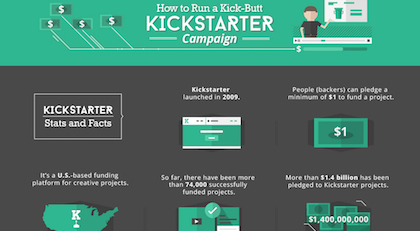With their latest infographic, I think that SurePayroll has put together some good tips and strategies that you can implement on your existing or upcoming Kickstarter campaign.
However, before we get into those points, let’s give a little bit of context to Kickstarter projects as a whole and get a clearer understanding of the crowdfunding marketplace.
Stats and Facts
As many of us now know, Kickstarter is a crowdfunding platform that launched in 2009. Backers can pledge as little as $1 to help support projects on Kickstarter in exchange for rewards. According to current Kickstarter statistics there have been over 86,000 successfully funded projects on the platform with over $1.7 billion total pledges made to Kickstarter campaigns!
In the time since they have launched, Kickstarter has attracted over 7.5 million total backers. Of that number more than 2.2 million have gone on to become repeat backers, and in the third quarter of 2014 335 backers pledged to 50 or more projects.
These numbers suggest that as more people hear about Kickstarter many are willing to give it a try. Some aren’t very interested or have had bad experiences, but there is a whole other group that loves everything that Kickstarter stands for and all the diverse projects that can be found on the platform keep them coming back for more.
Even though the media focuses on super successful Kickstarter campaigns, the truth is that only about 40% of campaigns on the platform meet their funding goal – and most successful projects raise less than $10,000. While the number of projects that have raised over $1M has grown to 105, this just shows how much work creators must put into their campaigns to get noticed and funded on time.
Kickstarter Tips and Tricks

Source: SurePayroll
The SurePayroll infographic includes a more comprehensive list of tips for running a great Kickstarter campaign. I decided to include only a select few that sometimes don’t get enough attention in this type of post:
- Solve a Problem – For your product to be successful it needs to be something that appeals to a large number of people. Whether it solves a common household problem, saves money or time or just saves people from boredom, make sure you can sum up the benefit of supporting your project in a couple sentences. This can help you narrow down your project’s focus as you come up with the text for your Kickstarter campaign. Remember that even though backers enjoy learning who you are and connecting with your story, simple asking them to fund your project because it is your dream will not be enough.
- Follow the Rules – This seems like a no-brainer night? Still I’ve seen a fair number of horror stories where a creator has put a lot of time and money into a project just to have it suspended, taken down, or not accepted by Kickstarter in the first place. Keep in mind that projects must create something to share with others while being honestly and clearly presented. Projects must not raise money for charity, offer financial incentives, or involve prohibited items.
- Make Time for Design – A well-designed Kickstarter page with logos and photos is one way to convince backers that your project is trustworthy and reliable. It shows that you have taken the time to present your project in a professional, appealing way. Giving your page some personality can also help keep potential backers interested as they read through your pitch. Here are some tools that I recommend checking out to spruce up the look and feel of your project.
- Update Backers – It is important to update backers with information about your progress throughout the Kickstarter campaign – and even afterward through e-mail updates. Updates can be used to share milestones, notify backers of any changes to the project, or to post something fun to encourage backers to keep spreading the word about your campaign to friends and family. Projects with a lot of updates tend to have high backer engagement, and regular updates can help reassure backers that your project is real and you are dedicated to seeing it through.
- Campaign Offline, Too – In the world of online crowdfunding, this is one point that often gets overlooked. Even when you choose the crowdfunding road, it is useful to grow recognition for your business by bringing your campaign offline too. A few ways that you can do this are pitching to people you meet who might be interested in your project or holding an event, such as a launch party. If you want to continue your business after the campaign is over the contacts you meet and networking you do in person can make a difference for your long term success.
Conclusion
SurePayroll’s infographic contains a lot of useful information if you are looking into launching their first Kickstarter campaign. Some of the other elements that were included in their summary were successful projects by category, and also information about Kickstarter’s growth over the past few years.
Taking a deeper look into platform statistics is a great way to make sure that a crowdfunding platform is right for your project before launching blindly. Once you do launch, I highly recommend enrolling in our Massive Kickstarter Success course which has exclusive techniques and secrets to boost the traffic to your campaign page and hit your goal early.




